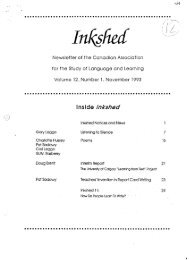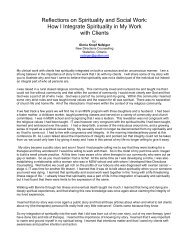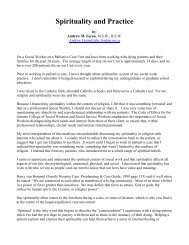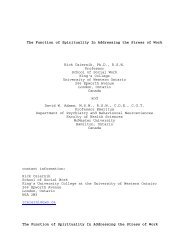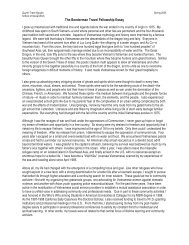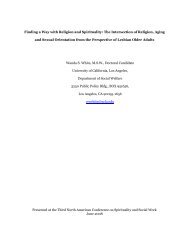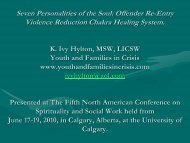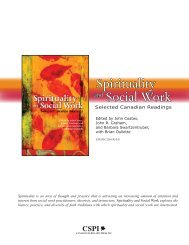The Wellness Wheel: An Aboriginal Contribution to Social Work
The Wellness Wheel: An Aboriginal Contribution to Social Work
The Wellness Wheel: An Aboriginal Contribution to Social Work
You also want an ePaper? Increase the reach of your titles
YUMPU automatically turns print PDFs into web optimized ePapers that Google loves.
<strong>The</strong> notions of wholeness and interconnectedness lead <strong>to</strong> another fundamental<br />
<strong>Aboriginal</strong> concept: that of balance. <strong>The</strong>se notions represent the inclusion of all aspects<br />
of one’s inner and outer life and imply the requirement of a balanced attribution of<br />
energy, attention and care between all components of a human being, i.e. the physical, the<br />
emotional, the mental and the spiritual, and between all related systems. From balance<br />
emerges justice, peace and harmony, affirms Hart (2002). Living in harmony is<br />
perceived as a necessity. Failure <strong>to</strong> do so puts people and the environment in positions of<br />
vulnerability and danger (Swinomish Tribal Mental Health Projects, 1991). Harmony is<br />
health, disharmony is illness. Like diabetes, disharmony causes malfunctions in other<br />
parts of the body being affected, be it at the individual or at any other level of society.<br />
From the above description of <strong>Aboriginal</strong> worldview and philosophy of life and<br />
wellness, it follows that, as stated by Sioui (1989:14), “the duty of man is <strong>to</strong> work for the<br />
Great Spirit” (translated by Loiselle) (see also Ouellette, 2002). ‘<strong>Work</strong>ing for the Great<br />
Spirit’ means that each person works, or is intended <strong>to</strong> work, for the good of His entire<br />
creation. Thus, each individual carries a responsibility for the well-being of the whole,<br />
be it the family, the community, the larger society or the world, including future<br />
generations (Ouellette, 2002). From the consciousness of one’s duty and responsibility in<br />
the world, awareness of personal accountability becomes acute as stated by Graveline<br />
(1998:58): “Through embracing this worldview, each individual becomes intensely<br />
aware of personal accountability for the welfare of others”.<br />
Figure no. 1, below, presents a graphic description of an <strong>Aboriginal</strong><br />
comprehensive worldview. <strong>The</strong> diagram is an integration of spirals originating from two<br />
sources: Graveline (1998:58) and Swinomish Tribal Mental Health Project (1991:127).<br />
6




